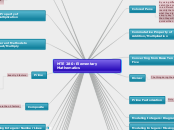MTE 280: Elementary Mathematics
Common Denominators (+/-)
Q: Why do we need to find common denominators when we add and subtract fractions?
A: The same size pieces
Exponents
3^2 x 5^2= 15^2
Multiple the 5 x 3 and keep the exponent the same.
Simplify Fractions
Estimations
Whole Numbers (#1): 4/5~1
Fractions (1/2): 3/8 < 1/2
1/4 & 3/4: 3/8 > 1/4
Subtracting Integers using Keep-Change-Change Method
Diamond Problems
Make an X on your paper, then fill in 2 numbers on the left and right. The numbers will add together to make the bottom number, and multiple to make the top number. The numbers can also be arranged in different orders.
Greatest Common Factor (GCF)
The largest number that divides evenly into all of the numbers.
Modeling Integers: Number Lines
The use of number line help students identify the answer using a visual aid.
Composite
More than 2 factors
Prime
Exactly 2 factors
Finding Different Methods to Add/Subtract/Multiply
Using repetition, punnett squares, Chinese method, etc.
Associative Property of Addition/Multiplication
You can add or multiply regardless of how the numbers are grouped. By 'grouped' we mean 'how you use parenthesis'.
Looking For a Pattern
When doing math problems always look for patterns that you can use. Students learn better if they have something to follow, such as a pattern. For example, when teaching exponents to students they will see that any number raised to the power of one will always be the original number (10^1=10, 5^1=5), or when any number is raised to the power of zero the number will always be one (10^0=1, 5^0=1). These are a few of the patterns that can be used in mathematics.
Juggling Lesson
This lesson was meant to teach the students that if you don't practice something, you will never learn it. By just showing the students how to juggle, it wasn't allowing them to throughly learn the concept and therefore the students weren't able to properly do it.
Exponent Rules
File is multiplying same base
Technique is adding exponents
Dividing Fractions
Example: 10 divided by 2...say "10 divided into groups of 2."
Decimals & Fractions
1/2=.5
1/4= .25, 3/4=.75
1/5=.2, 2/5=.4, 3/5=.6, 4/5=.8
1/3=.3 (repeat), 2/3=.6 (repeat)
1/10=.1, 9/10=.3
Fractions
Multiply by what is missing.
For example,
1/8 + 5/6 ----> (3/3) 1/8 + 5/6 (4/4)
Multiplying Integers
3(4) is 3 groups of 4 positives.
3(-4) is 3 groups of 4 negatives.
-2(4) is taking away 2 groups of 4 positives.
Generic Rectangles (Area Model)
This is used when multiplying binomials and trinomials.
Modeling Integers: Missing Addend
This method is re-writing the problem in a new way to solve it, by replacing a number with the letter x.
Ex:
5+2=7
Re-write as:
5=x-2...
x=7
Modeling Integers: Diagram
The colored tiles help represent positive and negative numbers. If written down, use pluses (+) and minuses (-).
Ex: -5 using 9 tiles:
- - - - - - -
+ +
Prime Factorization
Only prime numbers being multiplied
Divisor
The thing doing the dividing
Converting from Base Ten to Base Five
Using the "upside down" division method. The answer must be less than the number five.
Commutative Property of Addition/Multiplication
Refers to moving stuff around. For addition, the rule is "a + b = b + a"
Colored Pens
By using different colored pens it allows the student to catch their mistakes easier. If each step they write is in a different color then it is much easier for them to identify that mistake because they can clearly see what they did wrong. The teacher could come over and simply say "look over your work in the color green," then they will see what they did wrong and correct it quicker than if everything was in one color.
Cornell Notes
How to properly take good, clear notes in Mathematics that you can easily study from for upcoming exams.
This website (hyperlink attached) goes through step by step how to use the Cornell Note taking style.

